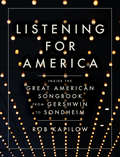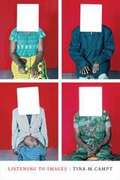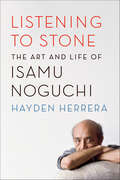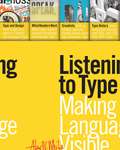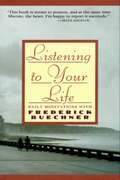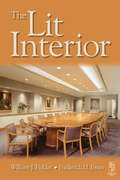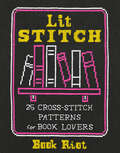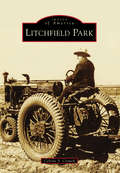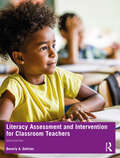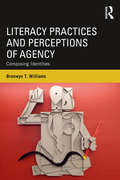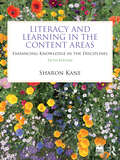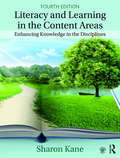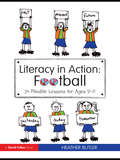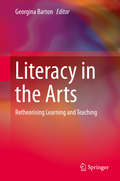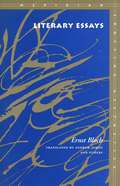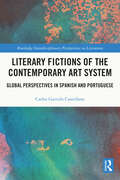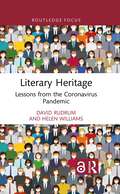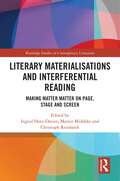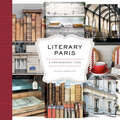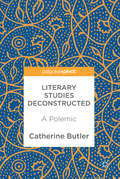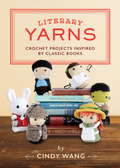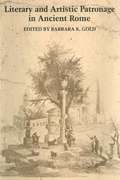- Table View
- List View
Listening for America: Inside The Great American Songbook From Gershwin To Sondheim
by Rob Kapilow“Not since the late Leonard Bernstein has classical music had a combination salesman-teacher as irresistible as Kapilow.” —Kansas City Star Few people in recent memory have dedicated themselves as devotedly to the story of twentieth- century American music as Rob Kapilow, the composer, conductor, and host of the hit NPR music radio program, What Makes It Great? Now, in Listening for America, he turns his keen ear to the Great American Songbook, bringing many of our favorite classics to life through the songs and stories of eight of the twentieth century’s most treasured American composers—Kern, Porter, Gershwin, Arlen, Berlin, Rodgers, Bernstein, and Sondheim. Hardly confi ning himself to celebrating what makes these catchy melodies so unforgettable, Kapilow delves deeply into how issues of race, immigration, sexuality, and appropriation intertwine in masterpieces like Show Boat and West Side Story. A book not just about musical theater but about America itself, Listening for America is equally for the devotee, the singer, the music student, or for anyone intrigued by how popular music has shaped the larger culture, and promises to be the ideal gift book for years to come.
Listening to Images
by Tina M. CamptIn Listening to Images Tina M. Campt explores a way of listening closely to photography, engaging with lost archives of historically dismissed photographs of black subjects taken throughout the black diaspora. Engaging with photographs through sound, Campt looks beyond what one usually sees and attunes her senses to the other affective frequencies through which these photographs register. She hears in these photos—which range from late nineteenth-century ethnographic photographs of rural African women and photographs taken in an early twentieth-century Cape Town prison to postwar passport photographs in Birmingham, England and 1960s mug shots of the Freedom Riders—a quiet intensity and quotidian practices of refusal. Originally intended to dehumanize, police, and restrict their subjects, these photographs convey the softly buzzing tension of colonialism, the low hum of resistance and subversion, and the anticipation and performance of a future that has yet to happen. Engaging with discourses of fugitivity, black futurity, and black feminist theory, Campt takes these tools of colonialism and repurposes them, hearing and sharing their moments of refusal, rupture, and imagination.
Listening to Others: Eduardo Coutinho's Documentary Cinema (SUNY series in Latin American Cinema)
by Natalia Brizuela; Krista BruneListening to Others is the first English-language volume dedicated solely to the vast corpus of the preeminent Brazilian director, Eduardo Coutinho (1933–2014). From his early work in the 1960s to his last, posthumous film in 2015, Coutinho transformed documentary filmmaking in Brazil and beyond. Described as an informal linguist and savage anthropologist, Coutinho filmed encounters with people different from himself that foregrounded their voices and his role as an attentive listener, creating a "cinema of listening." This collection brings together leading scholars of film, literature, visual culture, Brazilian studies, and Latin American studies, from the United States and Latin America, to examine both Coutinho's masterpieces and less studied films. Using a range of approaches, the contributors invite new ways of understanding the documentarian's trajectory and importance as his work transformed in response to dictatorship, democratization, and other political, social, and technological changes over the course of five decades. The volume also features original translations of a selection of Coutinho's writings and key texts by Brazilian critics to offer a historical perspective on his filmmaking and its reception.
Listening to Stone: The Art and Life of Isamu Noguchi
by Hayden HerreraThroughout the twentieth century, Isamu Noguchi was a vital figure in modern art. From interlocking wooden sculptures to massive steel monuments to the elegant Akari lamps, Noguchi became a master of what he called the "sculpturing of space." But his constant struggle—as both an artist and a man—was to embrace his conflicted identity as the son of a single American woman and a famous yet reclusive Japanese father. "It's only in art," he insisted, "that it was ever possible for me to find any identity at all." In this remarkable biography of the elusive artist, Hayden Herrera observes this driving force of Noguchi's creativity as intimately tied to his deep appreciation of nature. As a boy in Japan, Noguchi would collect wild azaleas and blue mountain flowers for a little garden in front of his home. As Herrera writes, he also included a rock, "to give a feeling of weight and permanence." It was a sensual appreciation he never abandoned. When looking for stones in remote Japanese quarries for his zen-like Paris garden forty years later, he would spend hours actually listening to the stones, scrambling from one to another until he found one that "spoke to him." Constantly striving to "take the essence of nature and distill it," Noguchi moved from sculpture to furniture, and from playgrounds to sets for his friend the choreographer Martha Graham, and back again working in wood, iron, clay, steel, aluminum, and, of course, stone. Throughout his career, Noguchi traveled constantly, from New York to Paris to India to Japan, forever uprooting himself to reinvigorate what he called the "keen edge of originality." Wherever he went, his needy disposition and boyish charm drew women to him, yet he tended to push them away when things began to feel too settled. Only through his art—now seen as a powerful aesthetic link between the East and the West—did Noguchi ever seem to feel that he belonged.Combining the personal correspondence of and interviews with Noguchi and those closest to him—from artists, patrons, assistants, and lovers—Herrera has created an authoritative biography of one of the twentieth century's most important sculptors. She locates Noguchi in his friendships with such artists as Buckminster Fuller and Arshile Gorky, and in his affairs with women including Frida Kahlo and Anna Matta Clark. With the attention to detail and scholarship that made her biography of Gorky a finalist for the Pulitzer Prize, Herrera has written a rich meditation on art in a globalized milieu. Listening to Stone is a moving portrait of an artist compulsively driven to reinvent himself as he searched for his own "essence of sculpture."
Listening to Type: Making Language Visible
by Alex W. WhiteWith this visually stunning primer, designers will develop the skills and vision to produce truly innovative, eye-catching type design. All the basics of type design are covered, and in-depth information is provided on more advanced topics such as the differences between type applications, how typography creates identity, and what best inspires readers. Chapters cover:The language of typeSpace and typeTypographic unityWhat makes readers respondType and identityEvolving type treatmentsReadability and legibilityA timeline of the evolution of writing and typographyDesigner Alex W. White packs the pages with fifteen hundred images-modern and ancient, specially created and found-that illustrate typographic concepts and continue to yield more complexity and connectivity with each viewing. Listening to Type proves that type is much more than groups of letterforms on a page; it is a language with the ability to convey meaning and evoke emotions beyond the spoken words it symbolizes.Allworth Press, an imprint of Skyhorse Publishing, publishes a broad range of books on the visual and performing arts, with emphasis on the business of art. Our titles cover subjects such as graphic design, theater, branding, fine art, photography, interior design, writing, acting, film, how to start careers, business and legal forms, business practices, and more. While we don't aspire to publish a New York Times bestseller or a national bestseller, we are deeply committed to quality books that help creative professionals succeed and thrive. We often publish in areas overlooked by other publishers and welcome the author whose expertise can help our audience of readers.
Listening to Your Life
by Frederick BuechnerDaily meditations taken from the works of an acclaimed novelist, essayist, and preacher who has articulated what he sees with a freshness and clarity and energy that hails our stultified imaginations.
Lit Interior
by Frederick H Jones William J FielderPresents an organised, comprehensive and easy to understand overview of the lighting design process. It covers every topic from the nature of light itself, through selecting the correct equipment, to preparing project plans and the finished design documents.Using a dummy example the student is taken through an entire project step by step where the full range of alternatives and design processes are illustrated. The easy to read conversational tone makes the novice feel at home with complex technical concepts and provides an excellent introduction to all newcomers to the subject. The book is ideal for those working in architecture, electrical engineering and interior design who will one day design lighting systems for others to build.A companion website runs alongside the book, at http://litinterior.com/, supporting distance learning projects, providing manufacturers data, calculation engines and downloadable courses for carrying our design exercises. The content of the courses will be linked directly to the book.Includes US codes and standards.
Lit Stitch: 25 Cross-Stitch Patterns for Book Lovers
by Book Riot“Savvily combines literary themes and cross-stitch designs in [a] visually appealing collection of projects . . . delightful.” —Publishers Weekly Inside Book Riot’s Lit Stitch, you’ll find a number of badass, bookish cross-stitch patterns to let you show off your love of all things literary. Some are for bookmarks, others are for wall decor, and still others can take on a whole host of finished outcomes. What they have in common is their literary bent—the patterns speak to all manner of literary-minded book lovers, who are happy to display their nerdier sides. And what better way than through your own cross-stitch art to hang on your wall, prop on your desk, or even gift to friends and family? Most if not all are beginner-friendly and can be completed in a few hours—instant stitchification! So grab yourself some excellent embroidery floss, hoops, and needles, and pick out one or more of these great cross-stitch patterns for your next project.
Litchfield Park
by Celeste S. CrouchIn 1908, William Kriegbaum, a California citrus grower, arrived as the first settler in what was to become Litchfield Park. He, along with other settlers from California, owned the land until 1916, when Paul Litchfield of Goodyear Tire & Rubber Company came to the area and purchased 16,000 acres to plant cotton for tires. In 1918, the townsite was planned with tree-lined streets and buildings to include an "organizational house" for Goodyear executives, which is now the famed Wigwam Resort. When new materials for tires were developed, cotton was no longer needed for cord. Shortly thereafter, Goodyear brought its tire-testing fleet to Litchfield, and farm equipment companies followed suit, sending engineers to design and test new machinery. The steel-wheeled tractor tire was replaced by Paul Litchfield's newly patented pneumatic tire as the standard for farm equipment. The World War II years brought changes to the area as an influx of new residents transformed the company town to a more planned community.
Literacy Assessment and Intervention for Classroom Teachers
by Beverly A. DeVriesThe Sixth Edition of this comprehensive resource helps future and practicing teachers recognize and assess literacy problems, while providing practical, effective intervention strategies to help every student succeed. DeVries thoroughly explores all major components of literacy, offering an overview of pertinent research, suggested methods and tools for diagnosis and assessment, intervention strategies and activities, and technology applications to increase students' skills. Substantively updated to reflect the needs of teachers in increasingly diverse classrooms, the Sixth Edition addresses scaffolding for English language learners and the importance of using technology and online resources. It presents appropriate instructional strategies and tailored teaching ideas to help both teachers and their students. The valuable appendices feature assessment tools, instructions, and visuals for creating and implementing the book's more than 150 instructional strategies and activities, plus other resources. New to the Sixth Edition: Up to date and in line with national, state, and district literacy standards, this edition covers the latest shifts in teaching and the evolution of these standards. New material on equity and inclusive literacy instruction, understanding the science of reading, using technology effectively, and reading and writing informational and narrative texts. New intervention strategies and activities are featured in all chapters and highlight a stronger technology component. Revamped companion website with additional tools, videos, resources, and examples of teachers using assessment strategies.
Literacy Assessment and Intervention for Classroom Teachers: For Classroom Teachers
by Beverly A. DeVriesThe fifth edition of this comprehensive resource helps future and practicing teachers recognize and assess literacy problems, while providing practical, effective intervention strategies to help every student succeed. DeVries thoroughly explores the major components of literacy, offering an overview of pertinent research, suggested methods and tools for diagnosis and assessment, intervention strategies and activities, and technology applications to increase students' skills. Updated to reflect the needs of teachers in increasingly diverse classrooms, the fifth edition addresses scaffolding for English language learners, and offers appropriate instructional strategies and tailored teaching ideas to help both teachers and their students. Several valuable appendices include assessment tools, instructions and visuals for creating and implementing the book's more than 150 instructional strategies and activities, and other resources. New to the Fifth Edition: Up-to-date and in line with ILA, CCSS, and most state and district literacy standards, this edition also addresses the important shifts and evolution of these standards. New chapter on Language Development, Speaking, and Listening covers early literacy, assessment, and interventions. New intervention strategies and activities are featured in all chapters and highlight a stronger technology component. Updated Companion Website with additional tools, resources, and examples of teachers using assessment strategies.
Literacy Practices and Perceptions of Agency: Composing Identities
by Bronwyn T. WilliamsIn this book, Bronwyn T. Williams explores how perceptions of agency—whether a person perceives and feels able to read and write successfully in a given context—are critical in terms of how people perform their literate identities. Drawing on interviews and observations with students in several countries, he examines the intersections of the social and the personal in relation to how and, crucially, why people engage successfully or struggle painfully in literacy practices and what factors and forces they regard as enabling or constraining their actions. Recognizing such moments and patterns can help teachers and researchers rethink their approaches to teaching to facilitate students’ sense of agency as writers and readers.
Literacy and Learning in the Content Areas: Enhancing Knowledge in the Disciplines
by Sharon KaneThe fifth edition of Literacy and Learning in the Content Areas: Enhancing Knowledge in the Disciplines provides readers with the knowledge, motivation, tools, and confidence for integrating literacy in their disciplinary classrooms. Offering a literature-based approach to teaching disciplinary literacy, the new edition shares important ways in which teachers of courses in the disciplines can enhance student learning of subject matter and skills while also fostering their growth in the many facets of literacy. Throughout each chapter, Kane provides engaging and creative strategies and activities to make literacy come alive in discipline-specific courses and to encourage students to explore and learn in the classroom. Embedded in each chapter are examples, resources, and strategies to help readers actively engage with and implement literacy practices. These features include Teaching in Action examples by subject area; Activating Prior Knowledge activities to stimulate critical thinking to prepare readers to learn complex theoretical and conceptual material about teaching, learning, and literacy; and end-of-chapter Application Activities to apply field experiences to classroom use.New to the Fifth Edition Every chapter of this new edition is updated to reflect the current approaches, standards, and benchmarks for discipline-specific literacy A new introduction with reading activities for professors to exemplify a common reading experience with their students, supported by online reading materials New book talks to highlight books that show disciplinary thinking in action, including literature related to art, physical education, economics, computer science, engineering, food science, music, robotics, environmental science, family and consumer science, and technology Expanded practical instructional strategies, with new examples focused on STEAM (science, technology, engineering, art, math) fields and topics relating to diversity and language, ESL/ENL, and modern language learning Updated examples and activities to emphasize students’ active involvement in their own learning
Literacy and Learning in the Content Areas: Enhancing Knowledge in the Disciplines (Fourth Edition)
by Sharon Kane<p>The Fourth Edition of Literacy and Learning in the Content Areas: Enhancing Knowledge in the Disciplines provides readers with the knowledge, motivation, tools, and confidence for integrating literacy in their disciplinary classrooms. Offering an original, literature-based approach to teaching disciplinary literacy, the new edition shares important ways in which teachers of courses in the disciplines can enhance student learning of subject matter and skills while also fostering their growth in the many facets of literacy. Throughout each chapter, Kane provides engaging and creative strategies and activities to make literacy come alive in discipline-specific courses and to encourage students to explore and learn in the classroom. <p>Embedded in each chapter are examples, resources, and strategies to help readers actively engage with and implement literacy practices. These features include Teaching in Action examples by subject area; Activating Prior Knowledge activities to stimulate critical thinking to prepare readers to learn complex theoretical and conceptual material about teaching, learning, and literacy; and end-of-chapter Application Activities to apply field experiences to classroom use. <p>New to the Fourth Edition: <p> <li>Every chapter of this new edition is updated to reflect the current approaches, standards, and benchmarks for discipline-specific literacy. <li>Enhanced Companion Website with BookTalks to introduce relevant books in many genres and subjects, encouraging readers to explore the books for themselves and providing a model for BookTalks in their own classrooms. <li>Expanded practical instructional strategies for teaching literacy in math, science, and social studies. <li>Updated to include newly published titles in children’s literature, young adult literature, and nonfiction.</li> </p>
Literacy in Action: 24 Flexible Lessons for Ages 9-11
by Heather ButlerGet ready for kick off and prepare to meet all of your literacy goals with Literacy in Action: Football. All year 5 and particularly year 6 teachers know about the pressure to help children deliver levels of achievement laid down by higher authorities than themselves. Many of the reluctant writers are passionate about football. Literacy in Action: Football could be the answer to their and your prayers, offering expert, tried and trusted techniques for teaching literacy, developed within the context of the 'Beautiful Game'. For those not bitten by the football bug there are alternative options. Literacy in Action: Football is a fun and inspiring addition to your literacy teaching. This unique classroom resource contains twenty-four lesson plans, each structured like a football match. For an hour, transform your classroom into Wembley Stadium! Each detailed lesson plan includes: short, kinaesthetic, focussed tasks with instant feedback and praise speaking and listening exercises – children engage in talking and collaborative work before completing a writing task key points from research in to boys’ writing in special notes for teachers alternative tasks available for those not interested in football differentiated material for a wide ability range. Literacy in Action: Football is written by Heather Butler, a writer, literacy consultant and story writing workshop leader. Literacy in Action: Football has been tested extensively by year 5 and year 6 teachers in leafy-green, inner city, multi-cultural and rural settings with amazing results. Why not try it for yourself?
Literacy in the Arts
by Georgina BartonThis book explores the many dialogues that exist between the arts and literacy. It shows how the arts are inherently multimodal and therefore interface regularly with literate practice in learning and teaching contexts. It asks the questions: What does literacy look like in the arts? And what does it mean to be arts literate? It explores what is important to know and do in the arts and also what literacies are engaged in, through the journey to becoming an artist. The arts for the purpose of this volume include five art forms: Dance, Drama, Media Arts, Music and Visual Arts The book provides a more productive exploration of the arts-literacy relationship. It acknowledges that both the arts and literacy are open-textured concepts and notes how they accommodate each other, learn about, and from each other and can potentially make education 'better'. It is when the two stretch each other that we see an educationally productive dialogic relationship emerge.
Literary Essays (Meridian: Crossing Aesthetics Series)
by Ernst BlochThe writings of Ernst Bloch represent one of the lasting linguistic and intellectual achievements of German expressionism. In them one finds a pathos and urgency, a spirit of breaking away and a projection toward a new way of seeing, thinking, and living together that has its origins in the artistic and intellectual unrest of this century's second decade. <P><P> Bloch's literary essays are not, strictly speaking, "theoretical" pieces, certainly not applications to literature of some pre-existing conceptual apparatus. Collectively they represent a field of experiment in which a thinker of astonishing originality exposes his thought to the provocation of literary, musical, and artistic works, but also to such phenomena as advertisements, landscapes, clichés and obsessive images, films, and forms of interaction in country and city. What is the function of musical accompaniment in a silent film? How does a writer's birthplace imprint itself on his intellect? What is the philosophical import of the detective novel? Why is anxiety more acute when its stimulus is aural rather than visual? What is the relation between modern art and the machinery of factory production? Such are the questions encountered here. Seldom is writing less automatic, willing to take more risks, and, quite simply, so fresh and refreshingly new. <P><P> The pieces gathered here, which date from 1913 to 1964, are held together by Bloch's view of the human as being always beyond itself, as anticipating itself and never positively there. This thrust beyond the horizon of positivity expresses itself in wishes, hopes, fantasies, dreams, imaginative creations, and utopian projects. Bloch s attention is always, and in the most diverse gestures, works, and productions, alert to the energies of political transcendence.
Literary Fictions of the Contemporary Art System: Global Perspectives in Spanish and Portuguese (Routledge Interdisciplinary Perspectives on Literature)
by Carlos Garrido CastellanoThe main objective of this book is to explain how contemporary literatures in Spanish and Portuguese are dealing with artistic creativity when artmaking is no longer a specialised field of cultural production, but rather an expanded field of socioeconomic interaction, personal and creative self-definition and collective imagination. The project positions the contemporary art novel as the most suitable place to understand how the economisation of cultural labour is affecting writers and artists alike. The authors examined in this book, including José Saramago, Rita Indiana Hernández, María Gainza, Mayra Santos Febres and Ondjaki (amongst others) explore the contradictions of the art market, the dynamics of art education, the multifaceted activity of curators and socially engaged artists in relation to broader debates on the role of culture in the configuration of socioeconomic dynamics. The book maps a new trend within contemporary literature that taps into the visual art system to reassess the role of literature in critical ways.
Literary Heritage: Lessons from the Coronavirus Pandemic
by David Rudrum Helen WilliamsLiterary Heritage examines the literary heritage sector in the post-pandemic moment. The book argues that this is a unique time for literary heritage management and demonstrates that the key to understanding it is an analysis of the transformations that took place because of the Covid-19 pandemic.Through an analysis of literary heritage sites across the UK’s four nations, this study provides an overview of practice from sites managed by national organisations as well as independent museums. Presenting a quantitative and qualitative overview of the challenges faced by the sector in the wake of the pandemic, Rudrum and Williams explore the innovations literary heritage organisations initiated in response. The book displays the wealth of ingenuity that was on display during this trying moment for the sector. It also looks forward to the new normal in the industry: a move towards the outdoors, increased use of online engagement, and creative arts and community programming that brings the literary past to the political present. Featuring interviews with 16 heritage practitioners, the book shares examples of best practice in the hope that lessons will be learned from the enforced closures prompted by the pandemic.Literary Heritage will be of great interest to academics and students working in Heritage Studies, Museum Studies, and English Literature. It will also appeal to a broad readership of cultural heritage professionals.
Literary Materialisations and Interferential Reading: Making Matter Matter on Page, Stage and Screen (Routledge Studies in Contemporary Literature)
by Martin Middeke Christoph Reinfandt Ingrid Hotz-DaviesThis book traces literature’s long history of repurposing representational language use for performative, “material” effects. It brings this tradition into dialogue with the recent material turn in literary and cultural theory, which seeks to supplant or at least rethink the foundational influence of the linguistic turn in the field. Drawing on a variety of cutting‑edge new‑materialist theories, this book programmatically outlines the contours of a methodology of Interferential Reading that is then brought to bear on examples ranging from Shakespeare, Donne, Keats and Tennyson to Northern Irish poets Colette Bryce and Sinéad Morrissey and Scottish poet Kathleen Jamie; from British thing essays to J. G. Ballard, John Berger, Nicola Barker, Richard Powers, Colum McCann, Tim Crouch, Hanya Yanagihara and Korean writer Han Kang, winner of the 2024 Nobel Prize for literature, and from the history of theatrical bodies to the intermedial as well as affective textures in very recent experimental theatre, live theatre broadcasting and media art.
Literary Paris: A Photographic Tour
by Nichole RobertsonAn essential addition to the library of every booklover and Francophile, this unique love letter to Paris offers an immersive photographic stroll through its literary delights, from historic bookstores to hidden cafes. Paris in Color author Nichole Robertson turns her lens onto spots both legendary and little-known, highlighting quiet moments that every booklover savors—inviting cafe scenes, comfy chairs, enticing book nooks—and the weathered charm of places steeped in centuries of literary history. Quotes by great writers such as Balzac and Colette are interspersed throughout, while a timeline and an index of featured locations round out the volume. This bijou treasure of a book will inspire every creative soul who dreams of following in the footsteps of their literary heroes.
Literary Studies Deconstructed: A Polemic
by Catherine ButlerLiterary Studies Deconstructed critiques the state of Literary Studies in the modern university and argues for its comprehensive reconstruction. It argues that Literary Studies as currently practised avoids engaging with much of literary experience and prioritises instead the needs of critics as a professional community: to teach and assess students, to demonstrate the creation of knowledge, and to meet the demands of governments, funders and other bodies. The result is that many areas centrally important to lay readers are largely omitted from critical discussion. Moreover, critical writing and its conventions are framed so as to mask and repress the subject’s contradictions. This lively and provocative book will be of interest to undergraduate and postgraduate students with an interest in the critical profession or literary theory, as well as to Literary Studies academics.
Literary Taste: How to Form It / With Detailed Instructions for Collecting a Complete Library of English Literature
by Arnold BennettAt the beginning a misconception must be removed from the path. Many people, if not most, look on literary taste as an elegant accomplishment, by acquiring which they will complete themselves, and make themselves finally fit as members of a correct society. They are secretly ashamed of their ignorance of literature, in the same way as they would be ashamed of their ignorance of etiquette at a high entertainment, or of their inability to ride a horse if suddenly called upon to do so. There are certain things that a man ought to know, or to know about, and literature is one of them :such is their idea.
Literary Yarns: Crochet Projects Inspired by Classic Books
by Cindy WangCrochet adorable amigurumi figures inspired by classic literature. Featuring 22 crocheted dolls drawn from 16 beloved novels and plays, this easy-to-follow craft book is perfect for bibliophiles and crafters of all skill levels. Literature lovers can decorate bookshelves, proclaim a love of reading, and show off crafting skills with adorable amigurumi, sweet crocheted characters that are simple to make and impossible to resist! All that’s needed are a few readily available materials and beginner crochet skills, and soon you’ll be hanging out with your favorite characters from classic literature. Take tea with a charming Elizabeth Bennet. Decorate the Christmas tree with a grumpy Ebenezer Scrooge. Solve mysteries with the help of a pocket-sized Sherlock Holmes. Bring Prince Hamlet to a play. And just try to keep Huck Finn out of trouble!
Literary and Artistic Patronage in Ancient Rome
by Barbara K. GoldVirgil, Horace, Catullus, Propertius--these are just a few of the poets whose work we would be without today were it not for the wealthy and powerful patrons upon whose support the Roman cultural establishment so greatly depended. Who were these patrons? What benefits did they give, to whom, and why? What effect did the support of such men as Maecenas and Pompey have on the lives and work of those who looked to them for aid? These questions and others are addressed in this volume, which explores all the important aspects of patronage--a topic crucial to the study of literature and art from Homer to the present day. The subject is approached from various vantage points: literary, artistic, historical. The essayists reach conclusions that dispel the many misconceptions about Roman patronage derived from seventeenth- and eighteenth-century models in England and Europe. An understanding of the workings of patronage is indispensable in helping us see how the Roman cultural establishment functioned in the four centuries of its flourishing and also in helping us read and enjoy specific poems and works of art. A book for all concerned with classical literature, art, and social history, Literary and Artistic Patronage in Ancient Rome not only deepens our understanding of the ancient world but also suggests important avenues for future exploration. Virgil, Horace, Catullus, Propertius--these are just a few of the poets whose work we would be without today were it not for the wealthy and powerful patrons upon whose support the Roman cultural establishment so greatly depended. Who were these patrons? What benefits did they give, to whom, and why? What effect did the support of such men as Maecenas and Pompey have on the lives and work of those who looked to them for aid? These questions and others are addressed in this volume, which explores all the important aspects of patronage--a topic crucial to the study of literature and art from Homer to the present day. The subject is approached from various vantage points: literary, artistic, historical. The essayists reach conclusions that dispel the many misconceptions about Roman patronage derived from seventeenth- and eighteenth-century models in England and Europe. An understanding of the workings of patronage is indispensable in helping us see how the Roman cultural establishment functioned in the four centuries of its flourishing and also in helping us read and enjoy specific poems and works of art. A book for all concerned with classical literature, art, and social history, Literary and Artistic Patronage in Ancient Rome not only deepens our understanding of the ancient world but also suggests important avenues for future exploration.
